
Google Ads is a powerful platform that allows advertisers to promote their products or services online and reach potential customers across the web. One of the key features of Google Ads is the dashboard, which provides valuable insights and data to help advertisers optimize their campaigns. Whether you are a beginner just starting out with Google Ads or an expert looking to improve your performance, mastering the Google Ads dashboard is essential for success.
When you first log in to your Google Ads account, the dashboard is the first thing you will see. The dashboard provides an overview of your account performance, including key metrics such as clicks, impressions, conversion rate, and cost per conversion. It also displays graphs and charts to help you visualize your data and track your progress over time. As a beginner, it can be overwhelming to navigate the dashboard and understand all the metrics and data being displayed. However, with practice and experience, you will become more familiar with the dashboard and be able to use it effectively to monitor and optimize your campaigns.
For beginners, the first step in mastering the Google Ads dashboard is to familiarize yourself with the different sections and features. The dashboard is divided into several tabs, each providing a different set of data and insights. The main tabs you will encounter are Campaigns, Ad Groups, Ads, Keywords, and Reports. Within each tab, you can view and analyze specific data related to your campaigns, such as performance metrics, budget allocation, and audience targeting. By exploring each tab and understanding the data being presented, you can gain valuable insights into your campaign performance and make informed decisions to optimize your ads.
As you become more experienced with Google Ads, you can take advantage of advanced features and functionalities within the dashboard to further improve your campaign performance. One of the key tools available in the dashboard is the Ad Preview and Diagnosis tool, which allows you to see how your ads appear to users and diagnose any issues that may be affecting their performance. By using this tool, you can quickly identify and fix any problems with your ads to ensure they are being displayed correctly to your target audience.
Another important feature of the Google Ads dashboard is the Auction Insights report, which provides valuable data on how your ads are performing compared to your competitors. By analyzing this data, you can identify opportunities to outperform your competitors and improve your ad positioning and visibility. Additionally, you can use the ad scheduling and bid adjustments features in the dashboard to optimize your campaigns for specific times of day or locations, ensuring that your ads are being shown to the right audience at the right time.
For experts looking to take their Google Ads campaigns to the next level, some several advanced strategies and techniques can be implemented using the dashboard. One such strategy is A/B testing, which involves creating multiple versions of your ads and testing them against each other to see which performs better. By using the experiments feature in the dashboard, you can easily set up and run A/B tests to identify the most effective ad variations and improve your campaign performance.
Another advanced technique that experts can use in the Google Ads dashboard is remarketing, which involves targeting users who have already visited your website or interacted with your ads. By creating remarketing lists and setting up remarketing campaigns in the dashboard, you can re-engage with these users and encourage them to convert. This can be a highly effective strategy for driving conversions and increasing your return on investment from your Google Ads campaigns.
In conclusion, mastering the Google Ads dashboard is essential for both beginners and experts looking to optimize their ad campaigns and improve their performance. By familiarizing yourself with the different sections and features of the dashboard, you can gain valuable insights into your campaign data and make informed decisions to drive better results. Whether you are just starting out with Google Ads or looking to take your campaigns to the next level, the dashboard is a powerful tool that can help you achieve your advertising goals.